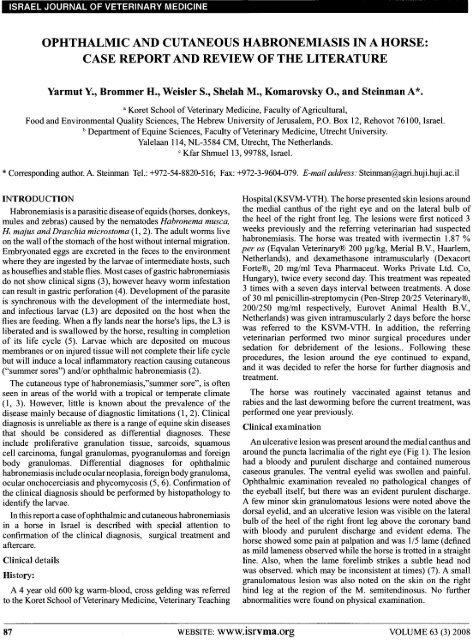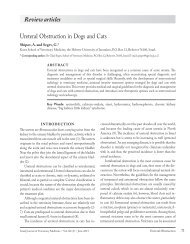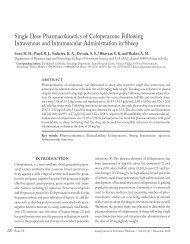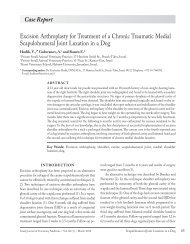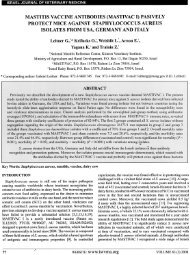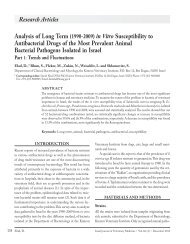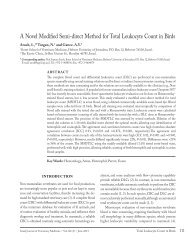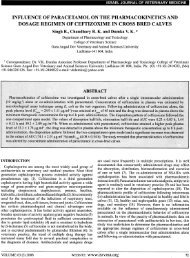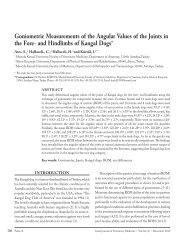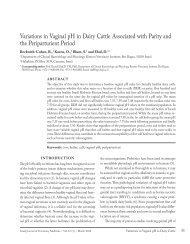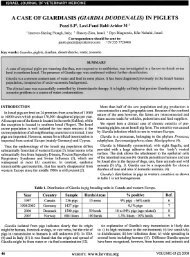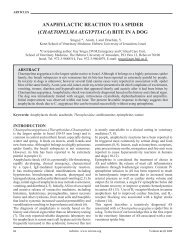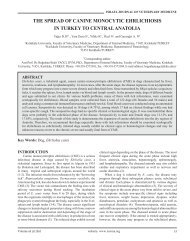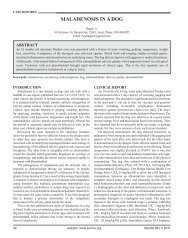ophthalmic and cutaneous habronemiasis in a horse: case report ...
ophthalmic and cutaneous habronemiasis in a horse: case report ...
ophthalmic and cutaneous habronemiasis in a horse: case report ...
You also want an ePaper? Increase the reach of your titles
YUMPU automatically turns print PDFs into web optimized ePapers that Google loves.
ISRAEL JOURNAL OF VETERINARY MEDICINE<br />
87 WEBSITE: www.isrvma.org VOLUME 63 (3) 200<br />
OPHTHALMIC AND CUTANEOUS HABRONEMIASIS IN A HORSE:<br />
CASE REPORT AND REVIEW OF THE LITERATURE<br />
Yarmut Y., Brommer H., Weisler S., Shelah M., Komarovsky O., <strong>and</strong> Ste<strong>in</strong>man A*.<br />
a<br />
Koret School of Veter<strong>in</strong>ary Medic<strong>in</strong>e, Faculty of Agricultural,<br />
Food <strong>and</strong> Environmental Quality Sciences, The Hebrew University of Jerusalem, P.O. Box 12, Rehovot 76100, Isra<br />
b<br />
Department of Equ<strong>in</strong>e Sciences, Faculty of Veter<strong>in</strong>ary Medic<strong>in</strong>e, Utrecht University.<br />
Yalelaan 114, NL-3584 CM, Utrecht, The Netherl<strong>and</strong>s.<br />
c<br />
Kfar Shmuel 13, 99788, Israel.<br />
* Correspond<strong>in</strong>g author. A. Ste<strong>in</strong>man Tel.: +972-54-8820-516; Fax: +972-3-9604-079. E-mail address: Ste<strong>in</strong>man@agri.huji.hu<br />
INTRODUCTION<br />
Hospital (KSVM-VTH). The <strong>horse</strong> presented sk<strong>in</strong> lesions aro<br />
Habronemiasis is a parasitic disease of equids (<strong>horse</strong>s, donkeys, the medial canthus of the right eye <strong>and</strong> on the lateral b<br />
mules <strong>and</strong> zebras) caused by the nematodes Habronema musca, the heel of the right front leg. The lesions were first not<br />
H. majus <strong>and</strong>Draschia microstoma (1,2). The adult worms live weeks previously <strong>and</strong> the referr<strong>in</strong>g veter<strong>in</strong>arian had suspe<br />
on the wall of the stomach of the host without <strong>in</strong>ternal migration. <strong>habronemiasis</strong>. The <strong>horse</strong> was treated with ivermect<strong>in</strong> 1.8<br />
Embryonated eggs are excreted <strong>in</strong> the feces to the environment per os (Eqvalan Veter<strong>in</strong>ary® 200 ug/kg, Merial B.V., Haar<br />
where they are <strong>in</strong>gested by the larvae of <strong>in</strong>termediate hosts, such Netherl<strong>and</strong>s), <strong>and</strong> dexamethasone <strong>in</strong>tramuscularly (Dexacort<br />
as houseflies <strong>and</strong> stable flies. Most <strong>case</strong>s of gastric <strong>habronemiasis</strong> Forte®, 20 mg/ml Teva Pharmaceut. Works Private Ltd.<br />
do not show cl<strong>in</strong>ical signs (3), however heavy worm <strong>in</strong>festation Hungary), twice every second day. This treatment was repe<br />
can result <strong>in</strong> gastric perforation (4). Development of the parasite 3 times with a seven days <strong>in</strong>terval between treatments. A<br />
is synchronous with the development of the <strong>in</strong>termediate host, of 30 ml penicil<strong>in</strong>-streptomyc<strong>in</strong> (Pen-Strep 20/25 Veter<strong>in</strong>ary<br />
<strong>and</strong> <strong>in</strong>fectious larvae (L3) are deposited on the host when 200/250 the mg/ml respectively, Eurovet Animal Health B.V.<br />
flies are feed<strong>in</strong>g. When a fly l<strong>and</strong>s near the <strong>horse</strong>'s lips, the L3 Netherl<strong>and</strong>s) is was given <strong>in</strong>tramuscularly 2 days before the h<br />
liberated <strong>and</strong> is swalowed by the <strong>horse</strong>, result<strong>in</strong>g <strong>in</strong> completion was referred to the KSVM-VTH. In addition, the referr<strong>in</strong>g<br />
of its life cycle (5). Larvae which are deposited on mucous veter<strong>in</strong>arian performed two m<strong>in</strong>or surgical procedures un<br />
membranes or on <strong>in</strong>jured tissue will not complete their life cycle sedation for debridement of the lesions.. Follow<strong>in</strong>g these<br />
but will <strong>in</strong>duce a local <strong>in</strong>flammatory reaction caus<strong>in</strong>g <strong>cutaneous</strong> procedures, the lesion around the eye cont<strong>in</strong>ued to expa<br />
("summer sores") <strong>and</strong>/or <strong>ophthalmic</strong> <strong>habronemiasis</strong> (2). <strong>and</strong> it was decided to refer the <strong>horse</strong> for further diagnosis<br />
treatment.<br />
The <strong>cutaneous</strong> type of <strong>habronemiasis</strong>,"summer sore", is often<br />
seen <strong>in</strong> areas of the world with a tropical or temperate climate The <strong>horse</strong> was rout<strong>in</strong>ely vacc<strong>in</strong>ated aga<strong>in</strong>st tetanus <strong>and</strong><br />
(1, 3). However, little is known about the prevalence of the rabies <strong>and</strong> the last deworm<strong>in</strong>g before the current treatmen<br />
disease ma<strong>in</strong>ly because of diagnostic limitations (1,2). Cl<strong>in</strong>ical performed one year previously.<br />
diagnosis is unreliable as there is a range of equ<strong>in</strong>e sk<strong>in</strong> diseases<br />
that should be considered as differential diagnoses. These<br />
Cl<strong>in</strong>ical exam<strong>in</strong>ation<br />
<strong>in</strong>clude proliferative granulation tissue, sarcoids, squamous An ulcerative lesion was present around the medial canthu<br />
cell carc<strong>in</strong>oma, fungal granulomas, pyogranulomas <strong>and</strong> foreign around the puncta lacrimalia of the right eye (Fig 1). The<br />
body granulomas. Differential diagnoses for <strong>ophthalmic</strong> had a bloody <strong>and</strong> purulent discharge <strong>and</strong> conta<strong>in</strong>ed num<br />
<strong>habronemiasis</strong> <strong>in</strong>clude ocular neoplasia, foreign body granuloma, <strong>case</strong>ous granules. The ventral eyelid was swolen <strong>and</strong> pa<br />
ocular onchocerciasis <strong>and</strong> phycomycosis (5, 6). Confirmation of Ophthalmic exam<strong>in</strong>ation revealed no pathological changes<br />
the cl<strong>in</strong>ical diagnosis should be performed by histopathology the to eyebal itself, but there was an evident purulent disch<br />
identify the larvae.<br />
A few m<strong>in</strong>or sk<strong>in</strong> granulomatous lesions were noted above<br />
In this <strong>report</strong> a <strong>case</strong> of <strong>ophthalmic</strong> <strong>and</strong> <strong>cutaneous</strong> <strong>habronemiasis</strong> dorsal eyelid, <strong>and</strong> an ulcerative lesion was visible on the<br />
<strong>in</strong> a <strong>horse</strong> <strong>in</strong> Israel is described with special attention to bulb of the heel of the right front leg above the coronary<br />
confirmation of the cl<strong>in</strong>ical diagnosis, surgical treatment <strong>and</strong> with bloody <strong>and</strong> purulent discharge <strong>and</strong> evident edema. T<br />
aftercare.<br />
<strong>horse</strong> showed some pa<strong>in</strong> at palpation <strong>and</strong> was 1/5 lame (d<br />
as mild lameness observed while the <strong>horse</strong> is trotted <strong>in</strong> a s<br />
Cl<strong>in</strong>ical details<br />
l<strong>in</strong>e. Also, when the lame forelimb strikes a subtle head<br />
History:<br />
was observed, which may be <strong>in</strong>consistent at times) (7). A<br />
granulomatous lesion was also noted on the sk<strong>in</strong> on the<br />
A 4 year old 600 kg warm-blood, cross geld<strong>in</strong>g was referred h<strong>in</strong>d leg at the region of the M. semitend<strong>in</strong>osus. No fu<br />
to the Koret School of Veter<strong>in</strong>ary Medic<strong>in</strong>e, Veter<strong>in</strong>ary Teach<strong>in</strong>g abnormalities were found on physical exam<strong>in</strong>ation.
ISRAEL JOURNAL OF VETERINARY MEDICINE<br />
VOLUME 63 (3) 2008 WEBSITE: www.isrvma.org 88<br />
Cl<strong>in</strong>ical pathology<br />
Ind. Ltd., Holon, Israel) for 10 days. After the cessation o<br />
Cytologic exam<strong>in</strong>ation of a direct smear taken from the lesion <strong>in</strong>travenous adm<strong>in</strong>istration of flunix<strong>in</strong> meglum<strong>in</strong>e the <strong>horse</strong> w<br />
around the medial canthus of the eye showed eos<strong>in</strong>ophilia. treated A orally twice a day with lgr phenylbutazone (Vetma<br />
complete blood count (CBC) <strong>and</strong> biochemical analysis were not Market<strong>in</strong>g ltd.) for 2 weeks. The nasolacrimal catheter wa<br />
performed. Packed cell volume (PCV) was 26% (reference range flushed daily with sterile isotonic sal<strong>in</strong>e. The stent b<strong>and</strong>age<br />
32-52%), total solids (TS) was 7 g/dl (reference range 5.7-7.9 removed g/ after three days <strong>and</strong> the hoof b<strong>and</strong>age was cha<br />
dl), <strong>and</strong> serum urea was 42 mg/dl (reference 10-40 mg/dl). every three days.<br />
Casemanagement<br />
The <strong>horse</strong> was discharged 12 days post-operatively. The<br />
sutures were removed <strong>and</strong> the wounds were healed by pr<br />
The presence of eos<strong>in</strong>ophils <strong>in</strong> the direct smear <strong>and</strong> the location <strong>in</strong>tention. The lesions around the medial canthus of the ey<br />
of the lesion supported the suspicion of <strong>habronemiasis</strong>. Due at to the lateral heel bulb of the hoof showed progress of h<br />
the risk of deterioration <strong>and</strong> damage to the eye it was decided by secondary <strong>in</strong>tention with a normal aspect of the granu<br />
to perform an extensive debridement under general anesthesia tissue. The <strong>horse</strong> did not show any lameness at the tim<br />
rather than treat<strong>in</strong>g it medicaly.<br />
discharge from the hospital.<br />
Surgery<br />
Histopathology <strong>and</strong> confirmation of the cl<strong>in</strong>ical diagnosis<br />
Preoperatively, the <strong>horse</strong> was given <strong>in</strong>travenously 10 m.u. The lesion adjacent to the eye revealed extensive epide<br />
benzylpenicill<strong>in</strong> sodium (Penicill<strong>in</strong> G sodium 10 m.u.®, 10 erosion <strong>and</strong> focal ulceration with dermal necrosis <strong>and</strong> ev<br />
m.uYvial, S<strong>and</strong>oz GmbH, Austria), 4 gr gentamyc<strong>in</strong> (Gentaveto- bacterial colonies. There was diffuse <strong>and</strong> heavy dermal<br />
5 Veter<strong>in</strong>ary® 50 mg/ml, V.M.D. N.V, Belgium) <strong>and</strong> 600 <strong>in</strong>filtration of numerous eos<strong>in</strong>ophils <strong>and</strong> fewer neutrophils<br />
mg flunix<strong>in</strong> meglum<strong>in</strong>e (Flunix<strong>in</strong> Veter<strong>in</strong>ary®, 50 mg/ml, smal cross-section of a degenerat<strong>in</strong>g larva was also seen<br />
Norbrook Laboratories Ltd, Irel<strong>and</strong>). Follow<strong>in</strong>g these preoperative<br />
medications, the <strong>horse</strong> was sedated <strong>in</strong>travenously that larvae were not seen.<br />
2). The lesion on the h<strong>in</strong>d leg revealed similar f<strong>in</strong>d<strong>in</strong>gs, e<br />
with 1000 mg xylaz<strong>in</strong>e (Chanaz<strong>in</strong>e®, 100 mg/ml, Chanele<br />
Pharm. Manufactur<strong>in</strong>g Ltd., Irel<strong>and</strong>) <strong>and</strong> subsequently <strong>in</strong>duced<br />
The lesion on the front leg revealed epidermal hyperp<br />
with 2000 mg ketam<strong>in</strong>e (Ketaset®, 100 mg/ml, Fort Dodge<br />
with hyperkeratosis <strong>and</strong> extensive ulceration, moderate to<br />
laboratories, USA) <strong>and</strong> 20 mg diazepam (Assival®, 10 ml/2<br />
marked fibrosis <strong>and</strong> diffuse eos<strong>in</strong>ophilic <strong>in</strong>filtration.<br />
ml, Teva Pharmaceut. Works Private Ltd. Co, Hungary). The The lesion above the eye revealed irregular, epidermal<br />
<strong>horse</strong> was positioned <strong>in</strong> left lateral recumbency, anaesthesia was hyperplasia <strong>and</strong> mild perivascular eos<strong>in</strong>ophilic <strong>in</strong>filtration.<br />
ma<strong>in</strong>ta<strong>in</strong>ed with isoflurane (100%, Nicolas Piramal (I) Ltd., UK) The lesions near the eye <strong>and</strong> on the h<strong>in</strong>d leg were com<br />
<strong>and</strong> 10 ml/kg/h of <strong>in</strong>travenous lactated R<strong>in</strong>ger's solution was with Habronema <strong>in</strong>festation. Severe eos<strong>in</strong>ophilic dermatitis<br />
given. A catheter was <strong>in</strong>serted <strong>in</strong>to the orifice of the nasolacrimal was seen <strong>in</strong> the sample colected from the right front leg,<br />
duct <strong>in</strong> the right nostril <strong>in</strong> order to flush the duct daily after might be the result of larval <strong>in</strong>fection. The lesion above th<br />
surgery with the aim to keep the puncta lacrimalia patent dur<strong>in</strong>g may represent a hypersensitivity reaction aga<strong>in</strong>st an unident<br />
wound heal<strong>in</strong>g. An extensive debridement of the lesion around agent, but which is probably also Habronema consider<strong>in</strong>g<br />
the medial canthus of the right eye was performed. Electrocautery histopathology of the other lesions.<br />
was used to stop haemorrhage <strong>and</strong> after debridement, a stent<br />
was sutured over the debrided lesion us<strong>in</strong>g nylon 0 (Monosof®, Folow up<br />
Nylon (Polyamide), Tyco Healthcare Group LP, USA) <strong>in</strong> a One month after discharge from the hospital, the wound a<br />
Lembert pattern to control <strong>and</strong> prevent bleed<strong>in</strong>g. One sk<strong>in</strong> the eye had healed but there was some degree of ectropion<br />
lesion on the ventral eyelid, two sk<strong>in</strong> lesions on the dorsal contraction of the scar (Fig 3). The lesion <strong>in</strong> the hoof had re<br />
eyelid, <strong>and</strong> the lesion <strong>in</strong> the area of the M. semitend<strong>in</strong>osus were<br />
excised. The wounds were closed with nylon 2/0 (Monosof®)<br />
to achieve primary <strong>in</strong>tention wound heal<strong>in</strong>g. Debridement was DISCUSSION<br />
also performed on the lesion on the bulb of heel of the right front In this <strong>report</strong>, confirmed <strong>case</strong> of <strong>ophthalmic</strong> <strong>and</strong> cutan<br />
hoof, proximal to the coronary b<strong>and</strong>. The hoof was b<strong>and</strong>aged <strong>habronemiasis</strong> to <strong>in</strong> a <strong>horse</strong> has been described. Previously,<br />
control <strong>and</strong> prevent the bleed<strong>in</strong>g. Samples from the lesion of number the of similar <strong>case</strong>s were suspected <strong>and</strong> treated accord<br />
eye, hoof <strong>and</strong> h<strong>in</strong>d leg were sent for histopathology. by veter<strong>in</strong>arians cl<strong>in</strong>icians (Haik R. personal communicatio<br />
Anesthesia was uneventful <strong>and</strong> the <strong>horse</strong> recovered well.<br />
but most <strong>case</strong>s were not confirmed by histopathology.<br />
Post-operative process<br />
Common sites for <strong>in</strong>festation by Habronema larvae are lim<br />
ventral aspect of the abdomen, prepuce, external genitalia<br />
Benzylpenicill<strong>in</strong> sodium at a dose of 10 m.u. four-times a males day (penis, urethral process), ocular <strong>and</strong> peri-ocular are<br />
<strong>and</strong> gentamyc<strong>in</strong> at a dose of 4 gr once a day were adm<strong>in</strong>istered (conjunctiva, medial canthus, nasolacrimal duct) <strong>and</strong> commiss<br />
<strong>in</strong>travenously for 3 days, <strong>and</strong> 300 mg flunix<strong>in</strong> meglum<strong>in</strong>e was of the lips (3,5). In a study conducted <strong>in</strong> 18 <strong>horse</strong> farms i<br />
adm<strong>in</strong>istered <strong>in</strong>travenously twice a day for 2 days. The <strong>horse</strong> 20 years ago, the prevalence of gastric <strong>habronemiasis</strong> was<br />
was also treated with hydrocortisone acetate 1.5% <strong>and</strong> neomyc<strong>in</strong> (8). The prevalence of <strong>habronemiasis</strong> justifies the need to <strong>in</strong>c<br />
sulphate 0.5% <strong>ophthalmic</strong> o<strong>in</strong>tment (Hycoc<strong>in</strong>e®, Rekah Pharm. it <strong>in</strong> the differential diagnosis of lesions on these body par
ISRAEL JOURNAL OF VETERINARY MEDICINE<br />
89 WEBSITE: www.isrvma.org VOLUME 63 (3) 2008<br />
A retrospective study was performed at Davis Veter<strong>in</strong>ary<br />
Teach<strong>in</strong>g Hospital on 63 <strong>horse</strong>s diagnosed with ocular or<br />
<strong>cutaneous</strong> <strong>habronemiasis</strong> to identify epidemiological features<br />
of the disease (5). Accord<strong>in</strong>g to this study Arabians were<br />
overrepresented, Thoroughbreds were underrepresented, no sex<br />
predisposition was noticed, the median age was 7.3 years, <strong>and</strong><br />
none of the <strong>horse</strong>s was less than 1 year old. Of the 63 <strong>horse</strong>s,<br />
only 8 had recurrent <strong>in</strong>fections <strong>in</strong> the follow<strong>in</strong>g years.<br />
In Western Europe, <strong>cutaneous</strong> <strong>habronemiasis</strong> has not<br />
been <strong>report</strong>ed so far (3). However, the occurrence of gastric 3. Gasthuys, F. M. R., Van Heerden, M. <strong>and</strong> Vercruysse, J<br />
<strong>habronemiasis</strong> has been <strong>report</strong>ed <strong>in</strong> a number of surveys. In Conjunctival habronemiosis <strong>in</strong> a <strong>horse</strong> <strong>in</strong> Belgium. Vet.<br />
Sweden 1.2% of 461 <strong>horse</strong>s were found positive (9), <strong>in</strong> France Rec. 154: 757-758,2004.<br />
8.5%o of 410 <strong>horse</strong>s were found positive (10) <strong>and</strong> <strong>in</strong> Belgium<br />
55% of 11 ponies were <strong>report</strong>edly positive (11).<br />
The exact pathogenesis of <strong>habronemiasis</strong> is unknown but it<br />
is highly probable that the disease <strong>in</strong>volves a hypersensitive<br />
reaction to dead or dy<strong>in</strong>g larvae because of the eos<strong>in</strong>ophilia<br />
seen <strong>in</strong> direct smears <strong>and</strong> <strong>in</strong> histopathological sections. The<br />
lesions usualy appear dur<strong>in</strong>g spr<strong>in</strong>g <strong>and</strong> summer, probably<br />
related to a high fly activity, <strong>and</strong> regress <strong>in</strong> w<strong>in</strong>tertime. Although<br />
it is a rather sporadic disease, certa<strong>in</strong> <strong>horse</strong>s show an annual<br />
6. Rebhun, W. C, Mirro, E. J, Georgi, M. E. <strong>and</strong> Kern, T.<br />
recurrence (2, 5).Diagnosis is chaleng<strong>in</strong>g, but based on the Habronemic Blepharoconjunctivitis <strong>in</strong> <strong>horse</strong>s. J. Am. Ve<br />
history, cl<strong>in</strong>ical signs <strong>and</strong> location of the lesions, <strong>habronemiasis</strong> Med. Assoc. 179: 469-472, 1981<br />
should be diagnosed. Histopathological exam<strong>in</strong>ation of a biopsy, 7. Ross, M. W: Movement. In: Ross, M. W. <strong>and</strong> Dyson, S.<br />
although less sensitive, is currently the method of choice for (Eds.): Diagnosis <strong>and</strong> management of lameness <strong>in</strong> the hors<br />
confirm<strong>in</strong>g the diagnosis. Characteristic histological lesions Saunders, Philadelphia, pp. 60-73, 2003.<br />
consist of eos<strong>in</strong>ophilic dermatitis <strong>and</strong> coagulative necrosis with 8. Sharir, B., Pipano, E., Markovics, A. <strong>and</strong> Danieli, Y.: Fie<br />
or without degeneration of nematode larvae <strong>in</strong> the centre, as was studies on gastro-<strong>in</strong>test<strong>in</strong>al <strong>in</strong>festation <strong>in</strong> Israeli <strong>horse</strong>s. I<br />
seen <strong>in</strong> this <strong>case</strong>, <strong>and</strong> as <strong>report</strong>ed previously (2,5). Molecular J. Vet. Med. 43: 223-227, 1987.<br />
diagnosis is be<strong>in</strong>g developed, but is not commercialy available<br />
yet. A PCR assay has been <strong>report</strong>ed for the diagnosis of gastric 9. Hoglund J., Ljungstrom, B. L., Nilsson, O., Lundquist, H<br />
<strong>habronemiasis</strong> (1, 12), <strong>cutaneous</strong> <strong>habronemiasis</strong> (2), <strong>and</strong> <strong>in</strong> Osterman, E. <strong>and</strong> Uggla, A.: Occurence of Gasterophilus<br />
epidemiological studies (13).<br />
<strong>in</strong>test<strong>in</strong>alis <strong>and</strong> some parasitic nematodes of <strong>horse</strong>s <strong>in</strong><br />
Sweden. Acta. Vet. Sc<strong>and</strong>. 38: 157-165, 1997.<br />
Many treatments for <strong>habronemiasis</strong> have been <strong>report</strong>ed,<br />
<strong>in</strong>clud<strong>in</strong>g corticosteroids for reduc<strong>in</strong>g the <strong>in</strong>flammatory 10. Colobert-Laugier, C, Lamidey, C, Brisseau, N., Moussu<br />
hypersensitivity reactions (5). Ivermect<strong>in</strong> has been used to kill<br />
the larvae <strong>and</strong> the adult worms <strong>in</strong> the stomach (5, 14). Topical<br />
comb<strong>in</strong>ations of anti-<strong>in</strong>flammatory, larvicidal, <strong>and</strong> antimicrobial<br />
<strong>in</strong>gredients are also recommended (5). In <strong>case</strong>s of lesions<br />
refractory to medical treatment, surgical <strong>in</strong>tervention is <strong>in</strong>dicated, 11. Dorny, P., Eysker, M., Demeulenaere, D., Smets, K. a<br />
as has been described for the <strong>horse</strong> <strong>in</strong> this <strong>report</strong>. Once surgery Vercruysse, J.: Study on the gastro<strong>in</strong>test<strong>in</strong>al metazoan paras<br />
is <strong>in</strong>dicated, extensive debridement should be performed s<strong>in</strong>ce fauna of ponies <strong>in</strong> Belgium, Vlaams Diergeneeskundig<br />
superficial debridement will usualy be <strong>in</strong>sufficient, lead<strong>in</strong>g Tijdschrift, 68:173-178, 1999.<br />
to progression of the condition which is probably related to<br />
persistence of degenerated larvae <strong>in</strong> the lesion. Fly control,<br />
proper removal <strong>and</strong> disposal of manure <strong>and</strong> protect<strong>in</strong>g exist<strong>in</strong>g<br />
wounds are essential for reduction of <strong>in</strong>cidence <strong>and</strong> prevention<br />
of recurrence of <strong>habronemiasis</strong> (3, 5, 6).<br />
REFERENCES:<br />
1. Giangaspero, A., Traversa, D. <strong>and</strong> Otranto, D.: A new too<br />
for the diagnosis <strong>in</strong> vivo of habronemosis <strong>in</strong> <strong>horse</strong>s. Equ<strong>in</strong><br />
vet. J. 37: 263-264, 2005.<br />
2. Traversa, D., Iorio, R., Petrizzi, L., De Amicis, I., Bran<br />
S., Meana, A., Giangaspero, A. <strong>and</strong> Otranto, D.: Molecula<br />
diagnosis of equid summer sores. Vet. Parasitol. 150: 1<br />
121,2007.<br />
4. Nadalian, M. Gh., Hosse<strong>in</strong>i, S. H., Tavassoli, A. <strong>and</strong> Raouf<br />
A. : Gastritis <strong>and</strong> gastric perforation due to habronema sp<br />
<strong>in</strong> the <strong>horse</strong>. J. Equ<strong>in</strong>e Vet. Sci. 17: 385-386, 1997.<br />
5. Pusterla, N., Watson, J. L., Wilson, W. D., Affolter, V. K<br />
<strong>and</strong> Spier, S. J.: Cutaneous <strong>and</strong> ocular <strong>habronemiasis</strong> <strong>in</strong><br />
<strong>horse</strong>s: 63 <strong>case</strong>s (1988-2002). J. Am. Vet. Med. Assoc. 2<br />
978-982, 2003.<br />
C. <strong>and</strong> Hamet, N.:. Prevalence of stomach nematodes<br />
{Habronema spp, Draschia megastoma <strong>and</strong> Trichostrong<br />
axei) <strong>in</strong> <strong>horse</strong>s exam<strong>in</strong>ed post mortem <strong>in</strong> Norm<strong>and</strong>y, Re<br />
de Medec<strong>in</strong>e Veter<strong>in</strong>aire, 151: 151-156, 2000.<br />
12. Traversa, D., Giangaspero, A., Iorio, R., Otranto, D., Paole<br />
B. <strong>and</strong> Gasser, R. B.: Semi-nested PCR for the specific<br />
detection of Habronema microstoma or Habronema mus<br />
DNA <strong>in</strong> <strong>horse</strong> faeces. Parasitology. 129: 733-739, 2004.<br />
This <strong>case</strong> <strong>report</strong> confirms the presence of the <strong>cutaneous</strong> <strong>and</strong> 13. Traversa, D., Iorio, R., Capelli, G., Paoletti, B., Bartol<strong>in</strong>i, R<br />
<strong>ophthalmic</strong> forms of <strong>habronemiasis</strong> <strong>in</strong> Israel. Thus abronemiasis Otranto, D. <strong>and</strong> Giangaspero, A.: Molecular cross-sectiona<br />
should be <strong>in</strong>cluded <strong>in</strong> the differential diagnosis when encounter<strong>in</strong>g survey of gastric habronemosis <strong>in</strong> <strong>horse</strong>s. Vet. Parasitol.<br />
typical lesions. The cl<strong>in</strong>ical diagnosis should be then confirmed 141:285-290,2006.<br />
<strong>and</strong> treated accord<strong>in</strong>gly as described here. Studies to assess the 14. Herd, R. P. <strong>and</strong> Donham, J. C: Efficacy of Ivermect<strong>in</strong> aga<br />
current prevalence of Habronema spp are required <strong>in</strong> Israel to <strong>cutaneous</strong> Draschia <strong>and</strong> Habronema <strong>in</strong>fection (summer<br />
evaluate its significance.<br />
sores) <strong>in</strong> <strong>horse</strong>s. Am. J. Vet. Res. 42: 1953-1955, 1981.
VOLUME 63 (3) 2008 WEBSITE: www.isrvma.org 90<br />
ISRAEL JOURNAL OF VETERINARY MEDICINE<br />
Figure 1: Cutaneous <strong>and</strong> <strong>ophthalmic</strong> <strong>habronemiasis</strong> adjacent Figure to 2: Histopathology of the lesion adjacent to the eye.<br />
the right eye of the <strong>horse</strong> on referral to the hospital. There There is an is dermal necrosis <strong>and</strong> diffuse <strong>and</strong> heavy dermal <strong>in</strong>filtr<br />
ulcerated lesion along the nasolacrimal duct - from the medial of numerous eos<strong>in</strong>ophils <strong>and</strong> fewer neutrophils. A smal cro<br />
canthus of the eye. It has progressed to a <strong>cutaneous</strong> lesion <strong>in</strong>ferior section through a degenerated larva of Habronema can be<br />
to the ventral eyelid. In addition there are a few smal ulcerated<br />
lesions dorsal <strong>and</strong> medial to the eye.<br />
Figure 3: The right eye of the <strong>horse</strong> one month after discharge.<br />
The lesion around the eye has healed <strong>and</strong> a smal scar rema<strong>in</strong>s. There is some degree of ectropion due to contraction


